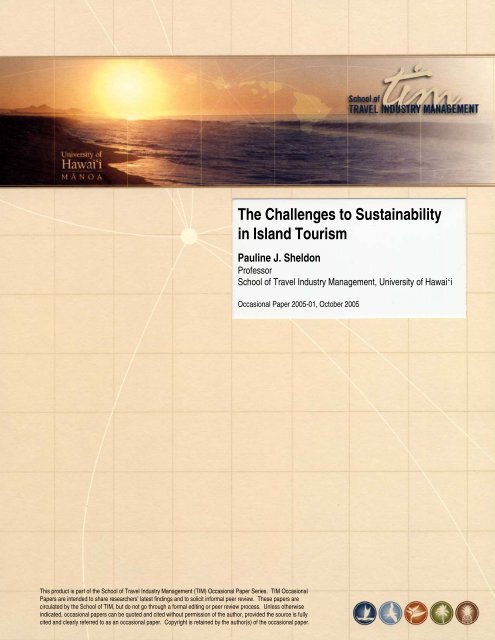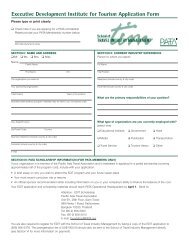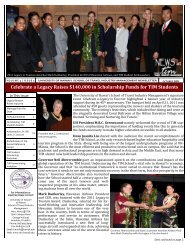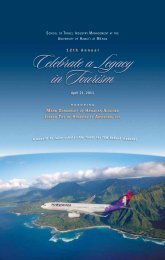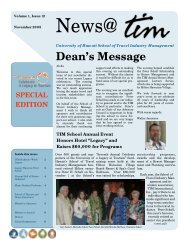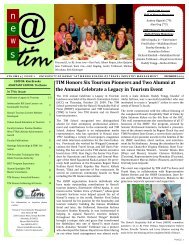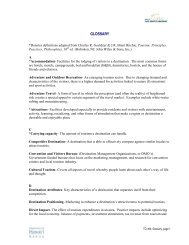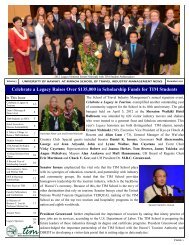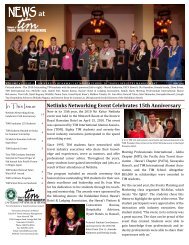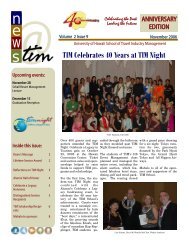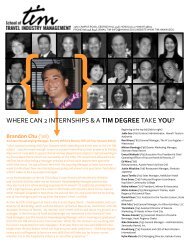The Challenges to Sustainability in Island Tourism - School of Travel ...
The Challenges to Sustainability in Island Tourism - School of Travel ...
The Challenges to Sustainability in Island Tourism - School of Travel ...
Create successful ePaper yourself
Turn your PDF publications into a flip-book with our unique Google optimized e-Paper software.
<strong>The</strong> <strong>Challenges</strong> <strong>to</strong> <strong>Susta<strong>in</strong>ability</strong><br />
<strong>in</strong> <strong>Island</strong> <strong>Tourism</strong><br />
Paul<strong>in</strong>e J. Sheldon<br />
Pr<strong>of</strong>essor<br />
<strong>School</strong> <strong>of</strong> <strong>Travel</strong> Industry Management, University <strong>of</strong> Hawai‘i<br />
Occasional Paper 2005-01, Oc<strong>to</strong>ber 2005<br />
This product is part <strong>of</strong> the <strong>School</strong> <strong>of</strong> <strong>Travel</strong> Industry Management (TIM) Occasional Paper Series. TIM Occasional<br />
Papers are <strong>in</strong>tended <strong>to</strong> share researchers’ latest f<strong>in</strong>d<strong>in</strong>gs and <strong>to</strong> solicit <strong>in</strong>formal peer review. <strong>The</strong>se papers are<br />
circulated by the <strong>School</strong> <strong>of</strong> TIM, but do not go through a formal edit<strong>in</strong>g or peer review process. Unless otherwise<br />
<strong>in</strong>dicated, occasional papers can be quoted and cited without permission <strong>of</strong> the author, provided the source is fully<br />
cited and clearly referred <strong>to</strong> as an occasional paper. Copyright is reta<strong>in</strong>ed by the author(s) <strong>of</strong> the occasional paper.
INTRODUCTION<br />
<strong>Island</strong>s are special places with a natural attraction for <strong>to</strong>urists and a special challenge <strong>to</strong> susta<strong>in</strong>ability. <strong>The</strong><br />
thousands <strong>of</strong> islands on the face <strong>of</strong> the earth <strong>in</strong>clude some <strong>of</strong> the f<strong>in</strong>est and most sought after dest<strong>in</strong>ations, such as<br />
the Balearic <strong>Island</strong>s, the Hawaiian <strong>Island</strong>s, the Galapagos <strong>Island</strong>s, the Canary <strong>Island</strong>s, the French Polynesian<br />
<strong>Island</strong>s, and the Caribbean islands. <strong>The</strong> mystique associated with islands is dependent on a blend <strong>of</strong> different<br />
lifestyles, <strong>in</strong>digenous cultures, unique land formations, flora and fauna, and ocean and coastal resources. To keep<br />
that mystique alive and thriv<strong>in</strong>g, islands must implement susta<strong>in</strong>able <strong>to</strong>urism policies <strong>in</strong> all areas <strong>in</strong>clud<strong>in</strong>g<br />
environmental, economic and socio-cultural. This paper will exam<strong>in</strong>e the unique challenges that islands face as<br />
they attempt <strong>to</strong> build susta<strong>in</strong>ability <strong>in</strong><strong>to</strong> their <strong>to</strong>urism development policies. It will also propose policies <strong>to</strong> assist <strong>in</strong><br />
atta<strong>in</strong><strong>in</strong>g and ma<strong>in</strong>ta<strong>in</strong><strong>in</strong>g quality island <strong>to</strong>urism. Examples from all types <strong>of</strong> island dest<strong>in</strong>ations are <strong>in</strong>cluded <strong>in</strong> the<br />
paper.<br />
TYPES OF ISLAND TOURISM DESTINATIONS<br />
<strong>Island</strong>s vary <strong>in</strong> many ways, and understand<strong>in</strong>g the various types clarifies for the decision-makers the policies that<br />
need <strong>to</strong> be used. One classification is islands’ climate which can be cold, temperate or tropical. Even though<br />
tropical islands (Caribbean, Hawaii, French Polynesia) tend <strong>to</strong> have most allure for <strong>to</strong>urists, cold and temperate<br />
islands also have environmental or cultural features and lifestyles that attract <strong>to</strong>urism – for example the Shetland<br />
islands <strong>of</strong>f the coast <strong>of</strong> Scotland. Baum 1997 describes the general attractivity <strong>of</strong> North Atlantic islands, <strong>in</strong>clud<strong>in</strong>g<br />
their remoteness, their small size, the slower pace <strong>of</strong> life, the chance <strong>to</strong> go back-<strong>in</strong>-time, the wilderness<br />
environment, the water-focused society and the sense <strong>of</strong> difference yet familiarity (Baum 1977). Very cold islands<br />
such as Iceland and Greenland <strong>of</strong>fer unique landscapes and flora and fauna and are alternate dest<strong>in</strong>ations <strong>of</strong>ten<br />
attract<strong>in</strong>g scientists, pho<strong>to</strong>graphers and other specialized travelers.<br />
Another island classification is the proximity <strong>to</strong> the related ma<strong>in</strong>land and also its size. <strong>Island</strong>s that are more remote<br />
and distant face more challeng<strong>in</strong>g accessibility and transportation issues due <strong>to</strong> their isolation. Visi<strong>to</strong>rs will tend <strong>to</strong><br />
stay longer <strong>in</strong> islands that are remote and larger, whereas those close <strong>to</strong> the ma<strong>in</strong>land and smaller may experience<br />
more excursionist <strong>to</strong>urism. For example, Cous<strong>in</strong> <strong>Island</strong> <strong>in</strong> the Seychelles, hosts only day visi<strong>to</strong>rs that leave the<br />
1
island at the end <strong>of</strong> each day (Shah, 2002). <strong>The</strong> island’s choice <strong>to</strong> host excursionists versus stay-over visi<strong>to</strong>rs<br />
requires a careful evaluation <strong>of</strong> the strengths and weaknesses <strong>of</strong> each type <strong>of</strong> <strong>to</strong>urism.<br />
A third classification is whether an island is a s<strong>in</strong>gle island or part <strong>of</strong> an archipelago. Multi-dest<strong>in</strong>ation travel <strong>in</strong><br />
island cha<strong>in</strong>s may be an added attraction for <strong>to</strong>urists, whereas the peace, or ‘sun, sand, sea’ experience <strong>of</strong> a s<strong>in</strong>gle<br />
island vacation may be the choice for others. Cooperative market<strong>in</strong>g and complementary product development is<br />
important for archipelago islands. This will create a diverse <strong>to</strong>uristic experience giv<strong>in</strong>g archipelagos an advantage<br />
over s<strong>in</strong>gle islands, particularly if they are small.<br />
A fourth classification is the governance <strong>of</strong> the island dest<strong>in</strong>ation. Some islands have au<strong>to</strong>nomous governments and<br />
others are part <strong>of</strong> the ma<strong>in</strong>land government system. Those with au<strong>to</strong>nomy have more control over the direction <strong>of</strong><br />
susta<strong>in</strong>able development <strong>of</strong> the island. <strong>The</strong>y are also more likely <strong>to</strong> reap the maximum economic benefits from<br />
<strong>to</strong>urism, without any revenue be<strong>in</strong>g leaked <strong>to</strong> the ma<strong>in</strong>land through taxes and other means. <strong>Island</strong>s under the<br />
jurisdiction <strong>of</strong> the ma<strong>in</strong>land need <strong>to</strong> ensure adequate representation <strong>in</strong> the government decision-mak<strong>in</strong>g.<br />
Fifth, some island dest<strong>in</strong>ations have grow<strong>in</strong>g resident populations (which may be due <strong>in</strong> part <strong>to</strong> <strong>to</strong>urism) and other<br />
with weak economies are experienc<strong>in</strong>g decl<strong>in</strong><strong>in</strong>g populations. In the latter case, there is a special need <strong>to</strong> ensure<br />
economic viability <strong>to</strong> prevent the out-migration <strong>of</strong> residents – especially young ones who look for opportunities<br />
elsewhere. Some islands, <strong>of</strong> course, have no human population and are simply nature-reserves, and others are<br />
privately owned with their own policies.<br />
<strong>The</strong> last classification relates <strong>to</strong> the homogeneity <strong>of</strong> the population and the socio-cultural susta<strong>in</strong>ability <strong>of</strong> island<br />
dest<strong>in</strong>ations. <strong>Island</strong>s with homogeneous, <strong>in</strong>digenous populations are particularly vulnerable <strong>to</strong> <strong>to</strong>urism development<br />
s<strong>in</strong>ce they have different cultures with different values than the source markets. <strong>The</strong> close <strong>in</strong>teraction that islands<br />
create between hosts and guests must be managed. <strong>Island</strong>s with more heterogeneous populations may be more<br />
resilient <strong>to</strong> socio-cultural impacts.<br />
It is clear from the categories above that islands differ <strong>in</strong> many ways from the ma<strong>in</strong>land and from each other. Each<br />
island has its uniqueness and that uniqueness needs <strong>to</strong> be nurtured and strengthened through susta<strong>in</strong>able <strong>to</strong>urism<br />
2
policies. <strong>The</strong> next section will exam<strong>in</strong>e the specific issues and problems that islands face <strong>in</strong> susta<strong>in</strong>able <strong>to</strong>urism<br />
development.<br />
SUSTAINABILITY ISSUES FACING ISLAND DESTINATIONS<br />
Many researchers have studied <strong>to</strong>urism <strong>in</strong> an island context. Some <strong>of</strong> these studies relate <strong>to</strong> specific islands (Malta,<br />
Briguglio and Briguglio, 2002, Seychelles, Shah 2002, French Polynesia, Salvat and Pailhe 2002, Boracay <strong>Island</strong>,<br />
Philipp<strong>in</strong>es, Trousdale, 1999, Canary <strong>Island</strong>s, Gil, 2003, Hawaiian <strong>Island</strong>s, Sheldon et al. 2005) and others address<br />
island <strong>to</strong>urism <strong>in</strong> a general, conceptual manner (McElroy, 2002, Croes, 2005). All islands must address issues <strong>of</strong><br />
economic impact, environmental consequences and those relat<strong>in</strong>g <strong>to</strong> the social, cultural and political fabric <strong>of</strong> the<br />
island all <strong>of</strong> which are affected by the density <strong>of</strong> <strong>to</strong>urism on the island. High <strong>to</strong>urist and resident densities <strong>in</strong> islands<br />
such as Malta are the source <strong>of</strong> many susta<strong>in</strong>ability problems (Bruguglio and Bruguglio, 2002) and carry<strong>in</strong>g capacity<br />
needs <strong>to</strong> be considered.<br />
Measures <strong>of</strong> <strong>to</strong>urism density are important for policy makers <strong>to</strong> assess possible growth scenarios. One measure <strong>of</strong><br />
<strong>to</strong>urism density or saturation, which considers all three areas <strong>of</strong> impact is the <strong>Tourism</strong> Penetration Index (TPI). TPI<br />
<strong>in</strong>cludes three variables: 1) visi<strong>to</strong>r spend<strong>in</strong>g per capita <strong>of</strong> population (economic measure), 2) average daily visi<strong>to</strong>rs<br />
per 1000 population (social measure), and 3) hotel rooms per square kilometer <strong>of</strong> land (environmental<br />
measure)(McElroy and Albuquerque, 1998). McElroy and Albuquerque used this <strong>to</strong> cluster Caribbean islands <strong>in</strong><strong>to</strong><br />
different clusters depend<strong>in</strong>g on whether their TPI is low, <strong>in</strong>termediate or high value. McElroy notes that for islands<br />
with low TPI’s the most important challenges are establish<strong>in</strong>g pr<strong>of</strong>itability and <strong>in</strong>ternational recognition, for those<br />
with <strong>in</strong>termediate TPI controll<strong>in</strong>g growth is the most important, and for those islands with the highest TPI the<br />
greatest challenge is <strong>to</strong> susta<strong>in</strong> vacation quality.<br />
<strong>The</strong> next sections will address the economic, environmental and socio-cultural challenges faced by islands <strong>in</strong> their<br />
quest <strong>to</strong> susta<strong>in</strong>ability.<br />
Economic Issues<br />
A challenge <strong>to</strong> the economic health <strong>of</strong> an island is the <strong>of</strong>ten limited economic resource base. <strong>Island</strong>s may have few<br />
resources or viable <strong>in</strong>dustries other than <strong>to</strong>urism <strong>to</strong> provide revenue and employment for the local population. <strong>The</strong><br />
3
value <strong>of</strong> agricultural and m<strong>in</strong><strong>in</strong>g commodities on the <strong>in</strong>ternational markets is decl<strong>in</strong><strong>in</strong>g and fish<strong>in</strong>g is less reliable as<br />
fish populations are be<strong>in</strong>g depleted, and global warm<strong>in</strong>g is chang<strong>in</strong>g the nature <strong>of</strong> coastl<strong>in</strong>es and fish movements.<br />
<strong>Tourism</strong> can be an economic catalyst for small island development. In fact, Croes (2004) suggests <strong>to</strong>urism as a <strong>to</strong>ol<br />
for small islands <strong>to</strong> enlarge their economies and overcome the disadvantages <strong>of</strong> smallness. <strong>The</strong> extra market<br />
demand produces economies <strong>of</strong> scale and <strong>in</strong>creases efficiency and decreases costs <strong>of</strong> production. <strong>Tourism</strong> also<br />
<strong>in</strong>creases competition, encourages new start-up bus<strong>in</strong>esses, democratizes market structure, and deters rentseek<strong>in</strong>g<br />
behaviors and corruption. He also argues that this competition can provide greater consumer choice, trade<br />
openness and <strong>in</strong>crease the quality <strong>of</strong> life for residents.<br />
Despite this, the revenue form <strong>to</strong>urism must rema<strong>in</strong> <strong>in</strong> the island economy as much as possible. Policies <strong>of</strong> import<br />
substitution <strong>to</strong> ensure m<strong>in</strong>imum economic leakages, and ‘buy local’ policies <strong>to</strong> maximize l<strong>in</strong>kages are essential.<br />
Taxation policies, entrepreneurial subsidies, and <strong>in</strong>vestment <strong>in</strong>centives are all useful <strong>to</strong> strengthen the economy. If<br />
development strategies are such that the <strong>in</strong>com<strong>in</strong>g wealth is leav<strong>in</strong>g the island economy, <strong>to</strong>urism needs <strong>to</strong> be redesigned.<br />
<strong>Island</strong>s under the governance <strong>of</strong> the ma<strong>in</strong>land need <strong>to</strong> ensure a fair share <strong>of</strong> tax revenue due. <strong>Island</strong>s<br />
under their own governance will ga<strong>in</strong> most economically.<br />
Seasonality <strong>in</strong> island <strong>to</strong>urism is another challenge <strong>to</strong> the economic susta<strong>in</strong>ability <strong>of</strong> the island and the well-be<strong>in</strong>g <strong>of</strong><br />
the island people (Nadal et al., 2004). Fluctuations <strong>in</strong> visi<strong>to</strong>r arrivals must be unders<strong>to</strong>od and mitigated through<br />
product and market diversification so that employment stabilizes and <strong>to</strong>urism <strong>in</strong>frastructures and superstructures<br />
are well utilized. Escalat<strong>in</strong>g land prices represent another economic concern <strong>in</strong> islands forc<strong>in</strong>g local residents out <strong>of</strong><br />
the hous<strong>in</strong>g market. This promotes out migration, lead<strong>in</strong>g <strong>to</strong> a possible dissolution <strong>of</strong> the culture, and second home<br />
ownership by foreigners. <strong>The</strong>se trends if unmitigated can generate a serious cha<strong>in</strong> <strong>of</strong> problems for the island<br />
economy.<br />
Environmental Issues<br />
Environmental issues <strong>of</strong> susta<strong>in</strong>ability on islands are multi-faceted, s<strong>in</strong>ce islands have diverse land formations,<br />
coastal areas, and wildlife species. <strong>Tourism</strong> <strong>of</strong>ten contributes <strong>to</strong> the environmental degradation (pollution, erosion,<br />
etc.) <strong>in</strong> small, island states which are host <strong>to</strong> fragile eco-systems rich <strong>in</strong> biodiversity. <strong>The</strong> isolation <strong>of</strong> the island<br />
environment created the biodiversity, and by open<strong>in</strong>g <strong>to</strong> <strong>to</strong>urism, some <strong>of</strong> that sheltered biodiversity is endangered.<br />
4
<strong>Island</strong>s’ prime <strong>to</strong>urist environmental resource is <strong>of</strong>ten the coastal regions (beaches, sand dunes, coral reefs) that<br />
are easily damaged, heavily used, and requir<strong>in</strong>g <strong>of</strong> careful visi<strong>to</strong>r management. <strong>The</strong> large amount <strong>of</strong> waste (solid<br />
and liquid) created by <strong>to</strong>urism is a problem s<strong>in</strong>ce space for its disposal on islands is limited.<br />
Socio-Cultural Issues<br />
<strong>Island</strong>s face complex socio-cultural issues, particularly those with <strong>in</strong>digenous populations. <strong>Tourism</strong> on islands,<br />
particularly small ones, br<strong>in</strong>gs hosts and guests <strong>in</strong><strong>to</strong> closer contact than on ma<strong>in</strong>land dest<strong>in</strong>ations, creat<strong>in</strong>g a more<br />
vulnerable situation for social disruption. Crime, commoditization <strong>of</strong> culture, and loss <strong>of</strong> traditional lifestyles, moral<br />
standards and family life impact islands more than ma<strong>in</strong>land dest<strong>in</strong>ations. Studies <strong>of</strong> resident sentiment and<br />
response <strong>to</strong> <strong>to</strong>urism <strong>in</strong> the islands <strong>of</strong> Malta and Hawaii (2003, Sheldon et al 2005) show the importance <strong>of</strong> this<br />
component. Community <strong>in</strong>tegration is key <strong>to</strong> successful and susta<strong>in</strong>able <strong>to</strong>urism development (Mitchell and Reid,<br />
2001), mean<strong>in</strong>g that all islanders affected by <strong>to</strong>urism must be <strong>in</strong>volved <strong>in</strong> the plann<strong>in</strong>g process. Stakeholders on<br />
islands are not only <strong>in</strong> closer proximity but also have long his<strong>to</strong>ries <strong>of</strong> conflict mak<strong>in</strong>g it even more important <strong>to</strong><br />
<strong>in</strong>volve them <strong>in</strong> the decision-mak<strong>in</strong>g process (Sheldon et al).<br />
With these issues <strong>in</strong> m<strong>in</strong>d, solutions and approaches <strong>to</strong> m<strong>in</strong>imize the problems are discussed <strong>in</strong> the next section.<br />
APPROACHES TO OVERCOME THE CHALLENGES TO ISLAND TOURISM<br />
<strong>The</strong> experience <strong>of</strong> many island dest<strong>in</strong>ations over the years has provided a rich source <strong>of</strong> policies that can<br />
assist with susta<strong>in</strong>ability on all levels. <strong>The</strong> next section presents examples <strong>of</strong> some <strong>of</strong> these policies<br />
Long-term, stakeholder-<strong>in</strong>volved plann<strong>in</strong>g<br />
Long term plann<strong>in</strong>g, developed with comprehensive community and stakeholder <strong>in</strong>put is becom<strong>in</strong>g and important<br />
foundation for <strong>to</strong>urism on islands (Trousdale, 1999, Sheldon et al, 2005). Plans also need <strong>to</strong> be values-based plans<br />
and reflect the <strong>in</strong>digenous culture and traditions. Long range plann<strong>in</strong>g must consider the balance <strong>of</strong> supply and<br />
demand <strong>of</strong> <strong>to</strong>urism, both quantitatively and qualitatively. A study <strong>of</strong> <strong>to</strong>urism <strong>in</strong> the Canary <strong>Island</strong>s showed that when<br />
these two growth patterns were out <strong>of</strong> balance the <strong>in</strong>dustry is not healthy (Gil, 2003).<br />
5
Once the plans have been put <strong>in</strong> place, methodologies <strong>to</strong> measure and moni<strong>to</strong>r impacts <strong>of</strong> <strong>to</strong>urism are essential.<br />
This requires the assignment <strong>of</strong> government agencies <strong>to</strong> the task <strong>of</strong> ongo<strong>in</strong>g moni<strong>to</strong>r<strong>in</strong>g <strong>of</strong> effects. <strong>The</strong> need for<br />
stakeholder-driven plann<strong>in</strong>g and <strong>in</strong>dica<strong>to</strong>r development is essential. In Hawaii for example, a process that covered<br />
almost two years brought <strong>to</strong>gether stakeholders <strong>to</strong> def<strong>in</strong>e their vision, goals and <strong>in</strong>dica<strong>to</strong>rs for susta<strong>in</strong>able <strong>to</strong>urism<br />
(Sheldon, Knox and Lowry, 2005). Community <strong>in</strong>volvement <strong>to</strong> guide <strong>to</strong>urism plann<strong>in</strong>g, development, management,<br />
research and evaluation <strong>of</strong> community-based <strong>to</strong>urism projects has been implemented <strong>in</strong> Taquile <strong>Island</strong> <strong>in</strong> Peru<br />
(Mitchell and Reid, 2001). On this island, decision-mak<strong>in</strong>g powers, local control and ownership, and type <strong>of</strong><br />
employment patterns were measure <strong>of</strong> community <strong>in</strong>volvement <strong>in</strong> the plann<strong>in</strong>g process.<br />
Empowerment <strong>of</strong> the island community and culture<br />
Empowerment <strong>of</strong> the island community and culture is a necessary part <strong>of</strong> plann<strong>in</strong>g (Di Castri, 2002). Frameworks <strong>to</strong><br />
protect and conserve the social and cultural structure are important also (Chris<strong>to</strong>u and Sigala, 2002). A build<strong>in</strong>g <strong>of</strong><br />
cultural pride through s<strong>to</strong>ry-tell<strong>in</strong>g and memory <strong>of</strong> traditions, and a sense <strong>of</strong> identity are paramount. This may<br />
<strong>in</strong>volve the re-enlivenment <strong>of</strong> festivals, arts, language, folk lore and policies <strong>to</strong> encourag<strong>in</strong>g local people <strong>to</strong> engage<br />
<strong>in</strong> entrepreneurial activities. Efforts <strong>to</strong>wards susta<strong>in</strong>able <strong>to</strong>urism <strong>in</strong> French Polynesian islands found the mean<strong>in</strong>gful<br />
<strong>in</strong>tegration <strong>of</strong> culture <strong>in</strong><strong>to</strong> the <strong>to</strong>urist experience difficult <strong>to</strong> accomplish (Salvat and Pailhe, 2002). Achiev<strong>in</strong>g a<br />
balance <strong>of</strong> respect for the culture and provid<strong>in</strong>g <strong>to</strong>urists with the opportunity <strong>to</strong> learn about and appreciate the<br />
culture is the core <strong>of</strong> the challenge<br />
Tourist and resident education are a critical part <strong>of</strong> island susta<strong>in</strong>ability. To empower the residents education and<br />
tra<strong>in</strong><strong>in</strong>g programs are needed for mean<strong>in</strong>gful careers <strong>in</strong> the <strong>in</strong>dustry. This may <strong>in</strong>volve distance education s<strong>in</strong>ce<br />
islands do not always have comprehensive tertiary education programs <strong>in</strong> <strong>to</strong>urism. Residents also need <strong>to</strong> learn<br />
about the impact <strong>to</strong>urism is hav<strong>in</strong>g on their community, through the shar<strong>in</strong>g <strong>of</strong> statistics and facts. <strong>The</strong> receptivity<br />
and openness <strong>to</strong> change and <strong>in</strong>novation is also needed. Education for <strong>to</strong>urists is also important. <strong>The</strong>y need <strong>to</strong> learn<br />
about the unique cultural and environmental features <strong>of</strong> the island and appropriate behaviors.<br />
Environmental management<br />
Given the challenges <strong>to</strong> the island’s ecosystems, environmental management is crucial for island susta<strong>in</strong>ability. <strong>The</strong><br />
paucity <strong>of</strong> land causes land usage issues, and the trade-<strong>of</strong>f <strong>of</strong> land for <strong>to</strong>urism versus agriculture and other<br />
6
<strong>in</strong>dustries, or preservation and conservation needs <strong>to</strong> be addressed. <strong>The</strong> environmental resources are a ma<strong>in</strong><br />
visi<strong>to</strong>r attraction and <strong>to</strong>urist <strong>in</strong>terfaces with those resources need <strong>to</strong> be planned and cared for. Conl<strong>in</strong>, 2002 <strong>in</strong> a<br />
study <strong>of</strong> Tasmania <strong>to</strong>urism, gives n<strong>in</strong>e different types <strong>of</strong> parks or reserves that can be created (national park, state<br />
reserve, nature reserve, game reserve, conservation area, nature recreational area, regional reserve, his<strong>to</strong>ric site<br />
and private sanctuary). This may <strong>in</strong>clude designation <strong>of</strong> zones that are <strong>of</strong>f-limits <strong>to</strong> <strong>to</strong>urists, and those that are only<br />
visitable with guides and <strong>in</strong>terpreters. <strong>Island</strong>s with unique wildlife must also take steps <strong>to</strong> susta<strong>in</strong> those populations.<br />
<strong>Tourism</strong> can actually assist as an anti-poach<strong>in</strong>g mechanism and an eng<strong>in</strong>e for conservation management when<br />
residents realize the economic value <strong>of</strong> the wildlife as <strong>in</strong> the Seychelles (Shah, 2002).<br />
Policies <strong>to</strong> keep the land and ocean unpolluted are also necessary. Waste management and recycl<strong>in</strong>g programs are<br />
essential, particularly on small islands. Also the use, through <strong>in</strong>centive programs if necessary, for alternative fuel<br />
sources (w<strong>in</strong>d, solar, geo-thermal etc.) will make the dest<strong>in</strong>ation more susta<strong>in</strong>able. <strong>The</strong> shortage <strong>of</strong> land for landfills<br />
may need waste <strong>to</strong> be sent <strong>to</strong> the ma<strong>in</strong>land for some islands (Trousdale, 1999). Recycl<strong>in</strong>g programs for all types <strong>of</strong><br />
waste are essential, and the use <strong>of</strong> alternative energy sources (w<strong>in</strong>d, solar, geothermal) is an important<br />
consideration s<strong>in</strong>ce <strong>to</strong>urists use much higher per capita user <strong>of</strong> energy than locals and rarely can islands survive on<br />
fossil fuels. Water shortages also are common on islands, limit<strong>in</strong>g the amount <strong>of</strong> <strong>to</strong>urism development.<br />
Environmental management <strong>in</strong>cludes recovery from natural disasters <strong>to</strong> which islands are so vulnerable (Meheux<br />
and Parker, 2004). Disasters such as tidal waves, volcanic eruptions, cyclones, drought and rise <strong>in</strong> sea level are all<br />
natural hazards that islands face. Funds for conservation and disaster management are needed and can be ga<strong>in</strong>ed<br />
through taxation, visi<strong>to</strong>r fees or other mechanisms (Shah, 2002).<br />
Visi<strong>to</strong>r Management<br />
Visi<strong>to</strong>r impact is so much greater on islands, requir<strong>in</strong>g <strong>to</strong>ols <strong>of</strong> visi<strong>to</strong>r management <strong>to</strong> ensure island susta<strong>in</strong>ability.<br />
Control <strong>of</strong> numbers <strong>of</strong> <strong>to</strong>urist arrivals is possible through the methods <strong>of</strong> transportation. Once the <strong>to</strong>urists arrive on<br />
the island they need <strong>in</strong>formation and guidance on possible attractions, <strong>to</strong>urs and events. One method <strong>of</strong> visi<strong>to</strong>r<br />
management is the zon<strong>in</strong>g <strong>of</strong> land for different uses, and the creation <strong>of</strong> national parks and conservation areas <strong>to</strong><br />
conserve his<strong>to</strong>ric sites, biological and geological diversity, preserve water quality, and <strong>to</strong> encourage education<br />
7
(Conl<strong>in</strong> 2002). <strong>The</strong> management <strong>of</strong> visi<strong>to</strong>rs on coral reefs is another issue <strong>of</strong> environmental management faced by<br />
many islands such as Hawaii and the French Polynesian islands (Salvat & Pailhe, 2002).<br />
Clear signage, <strong>in</strong>formation and <strong>in</strong>terpretive <strong>in</strong>formation assist the <strong>to</strong>urists <strong>in</strong> f<strong>in</strong>d<strong>in</strong>g and understand<strong>in</strong>g the<br />
attractions. Guides, rangers, wardens and other staff can guide <strong>to</strong>urists through delicate environments. <strong>The</strong><br />
recognition that visi<strong>to</strong>rs seek education and knowledge <strong>of</strong> species and land formations requires good <strong>in</strong>terpretative<br />
systems. <strong>The</strong> private sec<strong>to</strong>r such as <strong>to</strong>ur opera<strong>to</strong>rs need guidel<strong>in</strong>es for places that are <strong>of</strong>f-limits or have restricted<br />
access. <strong>The</strong> Galapagos archipelago with its unique biodiversity had <strong>to</strong> use visi<strong>to</strong>r management techniques due <strong>to</strong><br />
the large volume <strong>of</strong> visi<strong>to</strong>rs (<strong>in</strong>clud<strong>in</strong>g scientists, writers, pho<strong>to</strong>graphers) want<strong>in</strong>g <strong>to</strong> see the nature reserves. <strong>The</strong>y<br />
attempted <strong>to</strong> control <strong>to</strong>ur opera<strong>to</strong>rs by ask<strong>in</strong>g them <strong>to</strong> adhere <strong>to</strong> cruise it<strong>in</strong>eraries fixed by the national parks<br />
however that has not been <strong>to</strong>tally successful (Grenier 2002). Standards and certification for employee<br />
performance particularly <strong>in</strong> the <strong>to</strong>ur-guid<strong>in</strong>g arena will help with the <strong>in</strong>terpretation and susta<strong>in</strong>ability <strong>of</strong> the island.<br />
Knowledge and Information Systems<br />
Knowledge and <strong>in</strong>formation systems can help islands market their <strong>to</strong>urism product and also manage their <strong>to</strong>urist<br />
resources. Web-based market<strong>in</strong>g by the public sec<strong>to</strong>r and by private suppliers helps islands locate and target the<br />
market segments they want, and reduces the reliance on <strong>to</strong>ur opera<strong>to</strong>rs. Dest<strong>in</strong>ation management systems with<br />
comprehensive product databases and other <strong>in</strong>formation <strong>to</strong> assist and educate the potential <strong>to</strong>urist are an important<br />
competitive <strong>to</strong>ols <strong>in</strong> the match<strong>in</strong>g <strong>of</strong> <strong>to</strong>urist and island experience.<br />
Because islands are smaller, it may be easier <strong>to</strong> <strong>in</strong>stall location specific technologies and databases and data<br />
communication systems. <strong>The</strong>se could <strong>in</strong>clude mobile visi<strong>to</strong>r <strong>in</strong>formation systems, geographic <strong>in</strong>formation systems<br />
(GIS) mapp<strong>in</strong>g systems, global position<strong>in</strong>g systems (GPS), and <strong>in</strong>telligent transportation systems. GIS systems<br />
comb<strong>in</strong>e data and spatial <strong>in</strong>formation <strong>to</strong> help planners conduct spatial analysis <strong>of</strong> <strong>to</strong>uristic areas. <strong>The</strong>y have been<br />
used for example <strong>in</strong> the Cayman <strong>Island</strong>s <strong>to</strong> assess the impact <strong>of</strong> <strong>to</strong>urism on fragile reefs and <strong>in</strong> Ch<strong>in</strong>a for disaster<br />
moni<strong>to</strong>r<strong>in</strong>g us<strong>in</strong>g remote sens<strong>in</strong>g data (Hall 1998). Location specific <strong>in</strong>formation can be displayed on hand-held<br />
devices <strong>to</strong> assist travelers <strong>in</strong> their knowledge <strong>of</strong> the dest<strong>in</strong>ation and its attractions. <strong>The</strong>y also can keep visi<strong>to</strong>rs on<br />
appropriate routes through warn<strong>in</strong>g messages, and can direct visi<strong>to</strong>rs’ attention <strong>to</strong> an item or species <strong>of</strong> <strong>in</strong>terest.<br />
<strong>The</strong> placement <strong>of</strong> GPS devices on wildlife may <strong>in</strong>crease visi<strong>to</strong>rs’ chances <strong>of</strong> view<strong>in</strong>g the species. <strong>The</strong> use <strong>of</strong> GPS<br />
8
devices on <strong>to</strong>urists can help <strong>to</strong> rescue them from dangerous situations <strong>in</strong> the ocean, the mounta<strong>in</strong>s or other<br />
wilderness areas (Sheldon, 2002).<br />
Information technology can support the plann<strong>in</strong>g and stakeholder <strong>in</strong>volvement processes on islands. For example,<br />
expert systems which simulate the knowledge-base <strong>of</strong> an expert can be used <strong>to</strong> facilitate decision mak<strong>in</strong>g for<br />
susta<strong>in</strong>able <strong>to</strong>urism. Groupware can be applied <strong>to</strong> build stakeholder consensus, and the Internet is a valuable<br />
resource <strong>to</strong> ga<strong>in</strong> community <strong>in</strong>put from residents <strong>in</strong> remote communities.<br />
Accessibility and transportation<br />
Accessibility and transportation <strong>to</strong> island communities is an important area <strong>of</strong> policy for islands. Different<br />
transportation modes both <strong>to</strong> the island and on the island are usually necessary, and can be used as a control<br />
mechanism for how many <strong>to</strong>urists visit the island. <strong>The</strong> security, safety and costs <strong>of</strong> such transportation are also<br />
important considerations (di Castri, 2002). <strong>The</strong> balance <strong>of</strong> public and private transport use by <strong>to</strong>urists is a policy<br />
variable. Once <strong>to</strong>urists use their own transportation (hire car, mo<strong>to</strong>rbicycle), the control <strong>of</strong> their activities on the<br />
island is drastically reduced. Some islands prohibit mo<strong>to</strong>rized vehicles <strong>in</strong> certa<strong>in</strong> areas, others suggest the use <strong>of</strong><br />
electrical vehicles that are quieter and less pollutive.<br />
Air transportation <strong>to</strong> islands is most common, however it leaves islands vulnerable <strong>to</strong> s<strong>to</strong>ppage <strong>of</strong> flights due <strong>to</strong><br />
strikes, terrorism etc., and vulnerable <strong>to</strong> high fares if there is little competition on the route. It also requires the use<br />
<strong>of</strong> land for airports. <strong>The</strong> low-cost carriers that serve many European island dest<strong>in</strong>ations <strong>to</strong>day is fuell<strong>in</strong>g growth <strong>in</strong><br />
second homes s<strong>in</strong>ce owners can travel very cheaply <strong>to</strong> their island property. With out this cheap form <strong>of</strong><br />
transportation, the development <strong>of</strong> a second home <strong>to</strong>urism market is <strong>in</strong> jeopardy.<br />
<strong>The</strong> ocean is a natural option for transportation – both functional and recreational. Yachts, boats and ferries <strong>of</strong><br />
different types are useful <strong>to</strong> transport the visi<strong>to</strong>rs from island <strong>to</strong> island. In the Hawaiian <strong>Island</strong>s a high-speed ferry<br />
between the islands is be<strong>in</strong>g added <strong>to</strong> provide additional capacity <strong>to</strong> the <strong>in</strong>ter-island flights. Large cruise ships, and<br />
their <strong>in</strong>terest <strong>in</strong> island ports-<strong>of</strong>-call, make expansion <strong>of</strong> island <strong>to</strong>urism a dist<strong>in</strong>ct possibility. <strong>The</strong> large 2,500 berth<br />
cruise ships are potential sources <strong>of</strong> extra visi<strong>to</strong>rs, however they br<strong>in</strong>g with them needs and impacts that may not<br />
always be <strong>in</strong> the best <strong>in</strong>terests <strong>of</strong> the susta<strong>in</strong>ability <strong>of</strong> the island. Accessibility <strong>to</strong> the island also <strong>in</strong>cludes data, voice<br />
9
and fax communications and credit card use. <strong>The</strong>se are necessary for a dest<strong>in</strong>ation <strong>to</strong> function well (di Castri,<br />
2002).<br />
Market<strong>in</strong>g and market diversification<br />
Market<strong>in</strong>g and market diversification is important for islands. Markets may be domestic or <strong>in</strong>ternational, but the<br />
match between island facilities and resources and the <strong>to</strong>urist is the most important consideration. Domestic markets<br />
are likely <strong>to</strong> create less socio-cultural disturbance and may therefore be preferred. When def<strong>in</strong><strong>in</strong>g market segments,<br />
islands <strong>of</strong>ten try <strong>to</strong> identify niches <strong>to</strong> generate the highest expenditure for the island, as was done <strong>in</strong> the Canary<br />
<strong>Island</strong>s (Diaz-Perez et al, 2004). Hawaii’s Strategic Plan 2005-2010 has a similar focus on the quality visi<strong>to</strong>r and<br />
focuses on expenditures and length <strong>of</strong> stay <strong>in</strong> its market<strong>in</strong>g plans. Product <strong>in</strong>novation <strong>to</strong> match those segments and<br />
the extension <strong>of</strong> the lifecycle for island <strong>to</strong>urism products are important components <strong>of</strong> island <strong>to</strong>urism market<strong>in</strong>g<br />
(Chris<strong>to</strong>u & Sigala, 2002). <strong>The</strong> development <strong>of</strong> niche markets based on the islands resources is an important<br />
market strategy. For example <strong>in</strong> Tasmania, Australia, they focused on agricultural based <strong>to</strong>urist activities such as<br />
farm-stays, agricultural museums, w<strong>in</strong>eries, and other activities based on crops such as lavender and raspberries<br />
(Conl<strong>in</strong>, 2002). Some islands with very popular and delicate attractions may choose <strong>to</strong> practice de-market<strong>in</strong>g <strong>of</strong><br />
sites that are over visited. <strong>The</strong> type <strong>of</strong> <strong>in</strong>frastructure and superstructure that the island <strong>in</strong>vests <strong>in</strong> will also determ<strong>in</strong>e<br />
the type <strong>of</strong> <strong>to</strong>urists that come. For example, the build<strong>in</strong>g <strong>of</strong> only luxury hotels <strong>in</strong> French Polynesia attracted only<br />
high-<strong>in</strong>come visi<strong>to</strong>rs (Salvat and Pailhe, 2002). Many islands are famous for the “sun, sand and sea” image and<br />
may want <strong>to</strong> diversify their product <strong>to</strong> attract a different type <strong>of</strong> <strong>to</strong>urist, for ‘sun, sea and sand’ can be found <strong>in</strong> many<br />
islands (Aguilo et al, 2005).<br />
SUMMARY<br />
This paper has identified some <strong>of</strong> the challenges fac<strong>in</strong>g islands <strong>in</strong> susta<strong>in</strong><strong>in</strong>g their <strong>to</strong>urism <strong>in</strong>dustry. It has also<br />
recommended some policies and approaches <strong>to</strong> assist <strong>in</strong> this area. Each island is unique and has unique attributes.<br />
<strong>The</strong> challenge <strong>to</strong> susta<strong>in</strong>able management is <strong>to</strong> keep those unique elements that are part <strong>of</strong> the mystique that<br />
attracts <strong>to</strong>urists. Shifts <strong>to</strong>ward homogeneity <strong>of</strong> <strong>to</strong>urism experiences without giv<strong>in</strong>g the visi<strong>to</strong>r an experience <strong>of</strong> ‘sense<br />
<strong>of</strong> place’ will not be susta<strong>in</strong>able <strong>in</strong> the long run either for the host community or for the <strong>to</strong>urism markets.<br />
10
REFERENCES<br />
Aguilo, E., J. Alegre, and M. Sard, 2005, “<strong>The</strong> persistence <strong>of</strong> the sun and sand <strong>to</strong>urism model”, <strong>Tourism</strong><br />
Management, vol 26 (2), pp 219-232.<br />
Baum, T., 1997 “<strong>The</strong> fasc<strong>in</strong>ation <strong>of</strong> islands: a <strong>to</strong>urist perspective” <strong>in</strong> <strong>Island</strong> <strong>Tourism</strong>: trends and prospects, eds.<br />
Lockhart, D.G. and D. Drakakis-Smith, London UK, P<strong>in</strong>ter.<br />
Bramwell, B., 2002 “Maltese Responses <strong>to</strong> <strong>Tourism</strong>”, Annals <strong>of</strong> <strong>Tourism</strong> Research, vol.30 (3), pp. 581-605.<br />
Briguglio, L and Marie Briguglio, “Susta<strong>in</strong>able <strong>Tourism</strong> <strong>in</strong> Small <strong>Island</strong>s: the Case <strong>of</strong> Malta”, <strong>in</strong> eds.di Castri and<br />
Balaji <strong>Tourism</strong>, Biodiversity and Information, Backhyus Publishers, Leiden 2002, pp. 169-184<br />
Chris<strong>to</strong>u, E and M Sigala, “<strong>Tourism</strong> on <strong>Island</strong>s and specific dest<strong>in</strong>ations: International scientific conference;<br />
University <strong>of</strong> the Aegean”, <strong>Tourism</strong> Management, 2002, vol 23 (1) pp. 102-103.<br />
Conl<strong>in</strong>, M. “Tasmania: Balanc<strong>in</strong>g Commercial and Ecological <strong>in</strong>terests <strong>in</strong> <strong>to</strong>urism development”, <strong>in</strong> eds.di Castri and<br />
Balaji <strong>Tourism</strong>, Biodiversity and Information, Backhyus Publishers, Leiden 2002, pp.197-212.<br />
Croes, R., 2005 “A paradigm shift <strong>to</strong> a new strategy for small island economies: Embrac<strong>in</strong>g demand side economics<br />
for value enhancement and long term economic stability”, <strong>Tourism</strong> Management,<br />
Di Castri, F., “Diversification, Connectivity and Local Empowerment for <strong>Tourism</strong> <strong>Susta<strong>in</strong>ability</strong> <strong>in</strong> South Pacific<br />
<strong>Island</strong>s – a Network from French Polynesia <strong>to</strong> Easter <strong>Island</strong>”, <strong>in</strong> eds.di Castri and Balaji <strong>Tourism</strong>, Biodiversity and<br />
Information, Backhyus Publishers, Leiden 2002, pp 257-284.<br />
Diaz-Perez, F., M. Bethencourt-Cejas and J. Alvarez-Gonzales, “<strong>The</strong> segmentation <strong>of</strong> Canary <strong>Island</strong> <strong>to</strong>urism<br />
markets by expenditure: Implications for <strong>to</strong>urism policy”, <strong>Tourism</strong> Management, 2004.<br />
Hall, P. “<strong>The</strong> Use <strong>of</strong> GIS based DSS for susta<strong>in</strong>able development: experience and potential”, UK, Open University.<br />
Gil, S., “<strong>Tourism</strong> Development <strong>in</strong> the Canary Isalnds”, Annals <strong>of</strong> Toursim Research, 2003, vol 30 (3) pp. 744-747.<br />
Grenier, C., “How <strong>Tourism</strong> Reduces Geodiversity and HOW it Could be Different: the Cases <strong>of</strong> the Galapagos<br />
Archipelago and Easter <strong>Island</strong>”, <strong>in</strong> eds.di Castri and Balaji <strong>Tourism</strong>, Biodiversity and Information, Backhyus<br />
Publishers, Leiden 2002, pp.233-255.<br />
McElroy, J. “<strong>The</strong> impact <strong>of</strong> <strong>Tourism</strong> <strong>in</strong> Small islands: A Global Comparison”, <strong>in</strong> eds.di Castri and Balaji <strong>Tourism</strong>,<br />
Biodiversity and Information, Backhyus Publishers, Leiden 2002 pp 151-167<br />
McElroy, J. and K. Albuquerque, “<strong>Tourism</strong> Penetration <strong>in</strong>dex <strong>in</strong> small Carribean islands”, 1998 vol 25(1), pp 145-<br />
168.<br />
11
Meheux, K,and E. Parker, “Tourist sec<strong>to</strong>r perceptions <strong>of</strong> natural hazards <strong>in</strong> Vanuatu and the implications for a small<br />
island develop<strong>in</strong>g state”, <strong>Tourism</strong> Management, 2004,<br />
Mitchell, R and D. Reid, “Community Integration: <strong>Island</strong> <strong>Tourism</strong> <strong>in</strong> Peru”, Annals <strong>of</strong> <strong>Tourism</strong> Research, vol 28 (1)<br />
2001, pp 113-139.<br />
Nadal, J., A. Font and A Rossello, “<strong>The</strong> economic determ<strong>in</strong>ants <strong>of</strong> seasonal patterns”, <strong>in</strong> Annals <strong>of</strong> <strong>Tourism</strong><br />
Research, vol 31(3), 2004pp. 697-711.<br />
Salvat, B. and Claire Pailhe, “<strong>Island</strong>s and Coral Reefs, Population and Culture, Economy and <strong>Tourism</strong> World View<br />
and a Case study <strong>of</strong> French Polynesia”, <strong>in</strong> eds.di Castri and Balaji <strong>Tourism</strong>, Biodiversity and Information, Backhyus<br />
Publishers, Leiden 2002, pp. 213-231<br />
Shah, N. J., “Bik<strong>in</strong>i and Biodiversity: <strong>Tourism</strong> and Conservation on Cous<strong>in</strong> <strong>Island</strong>, Seychelles”, <strong>in</strong> eds.di Castri and<br />
Balaji <strong>Tourism</strong>, Biodiversity and Information, Backhyus Publishers, Leiden 2002, pp.185-196<br />
Sheldon, P., “Information Technology Contributions <strong>to</strong> Biodiversity <strong>in</strong> <strong>Tourism</strong>: the Case <strong>of</strong> Hawaii”, <strong>in</strong> eds. di Castri<br />
and Balaji, <strong>Tourism</strong>, Biodiversity and Information, Backhyus Publishers, Leiden 2002, pp. 449-456.<br />
Sheldon, P, J. Knox and K. Lowry, “Susta<strong>in</strong>able <strong>Tourism</strong> <strong>in</strong> Mass Destiantions: <strong>The</strong> Case <strong>of</strong> Hawaii”, 2005, <strong>Tourism</strong><br />
Review International.<br />
Trousdale, W., 1999, “Governance <strong>in</strong> Context: Boracay <strong>Island</strong>, Philipp<strong>in</strong>es” Annals <strong>of</strong> <strong>Tourism</strong> Research, pp. 840-<br />
867.<br />
12


